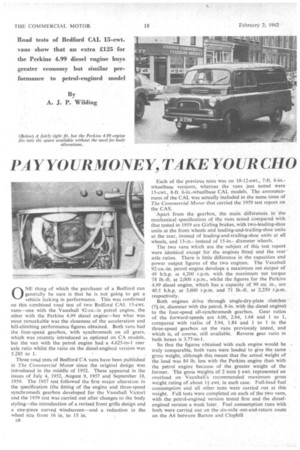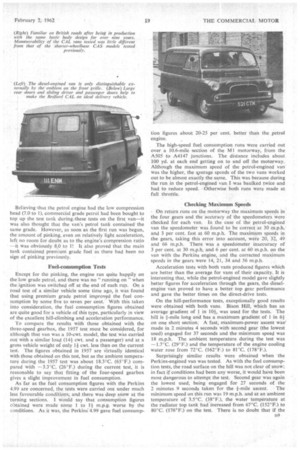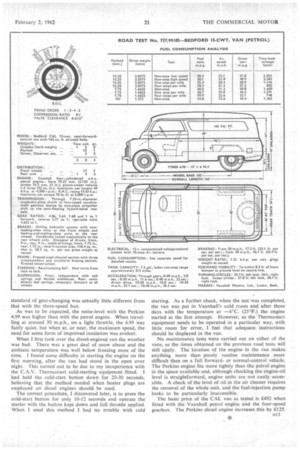PAY YOUR MONEY,TAKE YOUR CHO
Page 62

Page 63

Page 64

Page 67

If you've noticed an error in this article please click here to report it so we can fix it.
Road tests of Bedford CAL 15-cwt. vans show that an extra £125 for the Perkins 4.99 diesel engine buys greater economy but similar performance to petrol-engined model By A. J. P. Wilding
0 NE thing of which the purchaser of a Bedford generally be sure is that he is not going to get a vehicle lacking in performance. This was confirmed on this combined road test of two Bedford CAL 15-cwt. vans—one with the Vauxhall 92-cu.-in petrol engine, the other with the Perkins 4.99 diesel engine—but what was most remarkable was the closeness of the acceleration and hill-climbing performance figures obtained. Both vans had the four-speed gearbox, with synchromesh on all gears. which was recently introduced as optional on CA models, but the van with the petrol engine had a 4.625-to-I rear axle ratio whilst the ratio on the diesel-engined version was
5.285 to I. ,
Three road tests of Bedford CA vans have been published in The Commercial Motor since the original design was introduced in the middle of 1952. These appeared in the issues of July 4, 1952, August 9, 1957 and September 18, 1959. The 1957 test followed the first major alteration in the specification (the fitting of the engine and three-speed synchromesh gearbox developed for the Vauxhall Victor) and the 1959 test was carried out after changes to the body styling—the introduction of a revised front grille design and a one-piece curved windscreen—and a reduction in the
can wheel size from 16 in. to 15 in. . o8
Each of the previous tests was on 10-12-cwt., 7-ft. 6-in.wheelbase versions, whereas the vans just tested were 15-cwt., 8-ft. 6-in.-wheelbase CAL models. The announcement of the CAL was actually included in the same issue of The Comtnercial Motor that carried the 1959 test report on the CAS.
Apart from the gearbox, the main differences in the mechanical specification of the vans tested Compared with that tested in 1959 are Girling brakes, with two-leading-shoe units at the front wheels and leading-and-trailing-shoe units at the rear, instead of leading-and-trailing-shoe units at all wheels, and 13-in.instead of 15-in.diameter 'wheels. '
The two vans which are the subject of this test report were identical except for the engines fitted and the rear axle ratios. There is little difference in the capacities and power output figures of the two engines. The Vauxhall 92-cu.-in. petrol engine develops a maximum net output of 49 b.h.p. at 4,200 r.p.m. with the maximum net torque 78 lb.-ft. at 2,000 r.p.m., whilst the figures for the Perkins 4.99 diesel engine, which has a capacity of 99 cu. in., are 40.5 b.h.p. at 3,600 r.p.m. and 71 lb.-ft. at 2,250 r.p.m. respectively.
Both engines drive through single-dry-plate clutches (71-in, diameter with the petrol, 8-in, with the diesel engine) to the four-speed all-synchromesh gearbox. Gear ratios of the forward-speeds are 4.06, 2.64, 1.68 and 1 to 1, compared with ratibs of 3.94, 1.84 and I to 1 in the three-speed gearbox on the vans previously tested, and which is, of course, still available. Reverse gear ratio in both boxes is 3.77-to-1.
So that the figures obtained with each engine would be truly comparable, both vans were loaded to give the same gross weight, although this meant that the actual weight of the load was 84 lb. less with the Perkins engine than with the petrol engine because of the greater weight of the former. The gross weights of 2 tons cwt. represented an overload on Vauxhall's recommended maximum gross weight rating of about 11 cwt. in each case. Full-load fuel consumption and all other tests were carried out at this weight. Full tests were completed on each of the two vans, with the petrol-engined version tested first and the dieselengined version a week later. Fuel consumption runs with both were carried out on the six-mile out-and-return route on the A6 between Barton and Clophill Believing that the petrol engine had the low compression head (7.0 to 1), commercial grade petrol had been bought to top up the test tank during,these tests on the first van—it was also thought that the van's petrol tank contained the same grade. However, as soon as the first run was begun, the amount of pinking, even on relatively light acceleration, left no room for doubt as to the engine's compression ratio —it was obviously 8,0 to 1! It also proved that the main tank contained premium grade fuel as there had been no sign of pinking previously.
Fuel-consumption Tests Except for the pinking, the engine ran quite happily on the low grade petrol, and there was no "running on when the ignition was switched off at the end of each run. On a road test of a similar vehicle some time ago, it was found that using premium grade petrol improved the fuel consumption by some five to seven per cent. With this taken into consideration, the fuel consumption figures obtained are quite good for a vehicle of this type, particularly in view of the excellent hill-climbing and acceleration performance.
To compare the results with those obtained with the three-speed gearbox, the 1957 test must be considered, for although that van was a 10-cwt. model, the test was carried out with a similar load (141 cwt. and a passenger) and at a gross vehicle weight of only lf cwt. less than on the current test. The figures obtained in 1957 are virtually identical with those obtained on this test, but as the ambient temperature during the 1957 test was about 18.3?C. (65°F.) compared with —3.3°C. (26°F.) during the current test, it is reasonable to say that fitting of the four-speed gearbox gives a slight improvement in fuel consumption.
As far as the fuel consumption figures with the Perkins 4.99 are concerned, the tests were carried out under much less favourable conditions, and there was deep snow at the turning sections. I would say that consumption figures obtained were made some I to If m.p.g. worse by the conditions. As it was, the Perkin 4.99 gave fuel consump tion figures about 20-25 per cent. better than the petrol engine.
The high-speed fuel consumption runs were carried out over a 10.6-mile section of the M1 motorway, from the A505 to A4147 junctions. The distance includes about 100 yd. at each end getting on to and off the motorway. Although the maximum speed of the petrol-engined van was the higher, the verage speeds of the two vans Worked out to be almost exactly the same, This was because during the run in the petrol-engined van I was baulked twice and had to reduce speed. Otherwise both runs were made at full throttle.
Checking Maximum Speeds
• On return runs on the motorway the maximum speeds in the four gears and the accuracy of the speedometers were checked for each van. In the case of the petrol-engined van the speedometer was found to be correct at 30 m.p.h. and 3 per cent. fast at 60 m.p.h. The maximum speeds in the gears, taking this error into account, were 20, 32, 49 and 66 m.p.h. There was a speedometer inaccuracy of 3 per cent. at 30 m.p.h. and 6 per cent. at 60 m.p.h. on the van with the Perkins engine, and the corrected maximum speeds in the gears were 14, 21, 34 and 56 m.p.h.
Acceleration tests with both vans produced figures which are better than the average for vans of their capacity. It is interesting that, while the petrol-engirted model gave slightly better figures for acceleration through the gears, the dieselengine van proved to have a better top gear performance and gave the better times on the direct-drive tests.
On the hill-performance tests, exceptionally good results were obtained with both vans. Bison Hill, which has an average gradient of 1 in 104, was used for the tests. The hill is .-mile long and has a maximum gradient of 1 in 61 on one short section. A fast, maximum-power ascent was( made in 2 minutes 4 seconds with second gear (the lowest used) engaged for 37 seconds and the minimum speed was 18 m.p.h. The ambient temperature during the test was —1.7°C. (29°F.) and the temperature of the engine cooling water rose from 72°C. (162°F.) to 81°C. (178°F.),
Surprisingly similar results were obtained when the Perkins-engined van was tested. As with the fuel consumption tests, the road surface on the hill was not clear of snow; in fact if conditions had been any worse, it would have been most dangerous to attempt the test. Second gear was again the lowest used, being engaged for 27 seconds of the
2 minutes 9 seconds taken for the f-mile ascent. The minimum speed on this run was 19 m.p.h. and at an ambient temperature of 3.5°C. (38°F.), the water temperature at the radiator top tank had increased from 67°C. (152°F.) to 80°C. (176°F.) on the test. There is no doubt that if the
road conditions had been normal the time would have been the same, if not better, than that of the petrol model.
Both vans started easily in bottom gear when facing up, and in reverse gear when facing down, the hill on the section with a 1-in-6i gradient. Second-gear restarts were afterwards attempted; the petrol van failed to get away in this ratio, but the diesel job just made it, although only when the clutch was slipped deliberately.
Because the braking systems of the two vehicles were identical and the gross laden weights were the same, brake tests were carried out an the first van tested only. The new brakes employed on the van gave appreciably better figures for maximum-pressure stops from both 20 and 30 m.p.h. than did the earlier designs. Stopping distances of 17.2 ft. from 20 m.p.h. and 36.1 ft. from 30 m.p.h. compare with 19.5 ft. and 48 ft respectively recorded with the previous layout on the 1957 test. The van was completely stable on the stops, which were over a road surface of smooth asphalt, and the maximum decelerations obtained were 85 per cent. from both speeds. Hand-brake efficiency from 20 m.p.h. was 38 per cent.-a very good figure.
DIO While at Bison Hill a run down was made with the same van to assess the fade characteristics of the brakes. The first part of the descent was made in neutral with the foot brake applied to restrict the speed to 20 m.p.h. Towards the bottom of the hill the gradient is less steep and for the last 200 yards top gear was engaged and full thottle applied with the brakes kept on to hold the speed at 20 m.p.h. At the end of the run a maximum-pressure brake stop from 20 m.p.h. gave a Tapley-meter reading of 78 per cent., showing that there was only a slight degree of fade.
In general the two vans handled in a similar way to the short-wheelbase models tested previously. There was a greater proportion of weight over the front wheels on the CAL vans because of the longer wheelbase and this improved the handling. One of the earlier reports included a comment that there was a tendency to wander. Neither of the current vans could be criticized on this score and behaved perfectly at all speeds, even though the steering was still quite light.
Gear-changing with the four-speed gearbox was good and I never had difficulty in getting into a gear. The standard of gear-changing was actually little different from that with the three-speed box.
As was to be expected, the noise-level with the Perkins 4.99 was higher than with the petrol engine. When travelling at around 30 m.p.h., on a light throttle, the 4.99 was fairly quiet, but when at, or near, the maximum speed, the need for some form of improved insulation was evident.
When I first took over the diesel-engined van the weather was bad. There was a great deal of snow about and the ambient temperature was well below freezing most of the time. I found some difficulty in starting the engine on the first morning, after the van had stood in the open over night. This turned out to be due to my inexperience with the C.A.V. Thermostart cold-starting• equipment fitted. I had held the cold-start button down for 20-30 seconds, believing that the method needed when heater plugs are employed on diesel engines should be used.
The correct procedure, I discovered later, is to press the cold-start button for only 10-12 seconds and operate the starter with the button kept down and full throttle applied. When I used this method I had no trouble with cold
starting. As a further check, when the test was completed, the van was put in Vauxhall's cold room and after three days with the temperature at -4°C. (25°f.) the engine started at the first attempt. However, as the Thermostart equipment needs to be operated in a particular way, with little room for error, I feel that adequate instructions should be displayed in the van.
No maintenance tests were carried out on either of the vans, as the times obtained on the previous road tests will still apply. The location of the engine in the van makes anything more than purely routine maintenance more difficult than on a full forwardor normal-control vehicle. The Perkins engine fits more tightly than the petrol engine in the space available and, although checking the engine-oil level is straightforward, engine units are not easily accessible. A check of the level of oil in the air cleaner requires the removal of the whole unit, and the fuel-injection pump looks to be particularly inaccessible.
The basicprice of the CAL van as tested is £492 when fitted with the Vauxhall petrol engine and the four-speed gearbox. The Perkins diesel engine increases this by £125.




























































































































